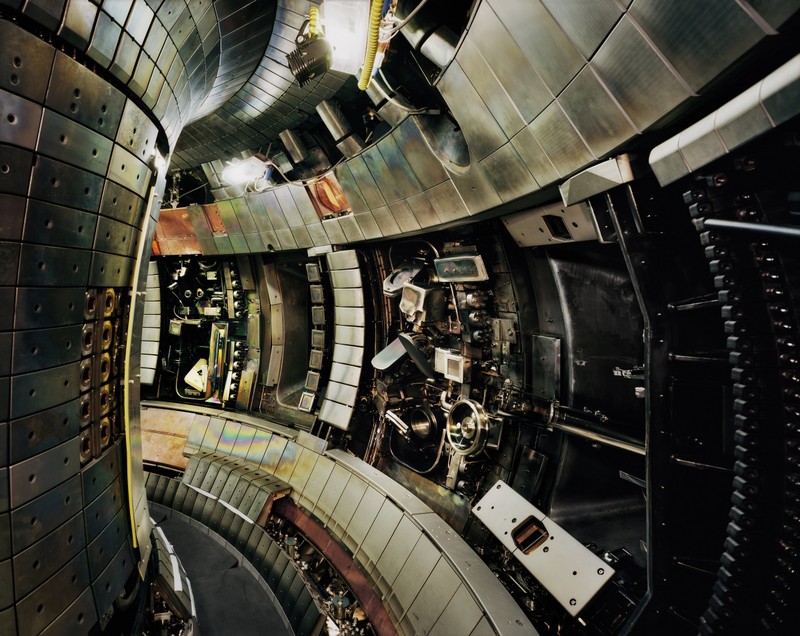Thomas Struth. Nature & Politics
11 Jun - 18 Sep 2016

Tokamak Asdex Upgrade Interior 2,
Max Planck IPP, Garching, 2009
Chromogenic print
141,6 x 176,0 cm,
Courtesy: Museum Folkwang, Essen
© Thomas Struth
Max Planck IPP, Garching, 2009
Chromogenic print
141,6 x 176,0 cm,
Courtesy: Museum Folkwang, Essen
© Thomas Struth
Thomas Struth is internationally considered one of the most important artists of his generation. For the first time, his work will be displayed at the Berliner Martin-Gropius-Bau. The exhibition will feature approximately 35 large-format photographs from the years 2005 through 2016.
Industrial production plants, research laboratories and operating rooms, but also everyday architecture or theme parks: Thomas Struth’s pictures of the last few years explore how human ambition and imagination become spatial, objective reality.
This ensemble of Struth’'s work shows us highly complex devices, structures and constructions that define our present, but are usually inaccessible to the public. These pictures tell of attempts to extend the limits of what is technically possible and to exceed natural reality through artificial worlds.
Struth is not only fascinated by complex structures, but by the mental endeavour displayed by them. “I wanted to explore the process of imagination. (...) I am only concerned with how something that at first was only a thought materializes and becomes part of reality. ‘Picturing something,’ this expression already describes the brain's ability to think in pictures.”
The photographs are about highly specialized imagination: Developments in space travel, plasma physics experiments or industrial facilities, such as oil rigs or blast furnaces, are products of the ideas and designs of experts. Struth’s detailed photographs show that these overwhelmingly complex constructions are also creations. Created by humans, they raise the question of how power and striving for power is documented in objects and how they then gain political importance. The pictures explore the creation, interpretation and reinterpretation of reality, memory and experience.
Thomas Struth (*1954) is one of the artists who helped photography gain a new intensity and effectiveness. He first studied painting under Gerhard Richter and, after 1976, photography under Bernd and Hilla Becher at the Kunstakademie Düsseldorf. Together with other Becher students, including Andreas Gursky, Thomas Ruff and Candida Höfer, they formed the so-called Düsseldorf School. As early as 1992, Struth's work was displayed at the documenta IX in Kassel.
Seeing precisely is at the center of his creative work. Whether it's the impenetrable thickets of Asian jungles, large format museum scenes ("Audiences") or his latest photographs of large technical facilities, he directs one's view to structures of the present which he documents and questions with great sharpness of detail. His pictures of landscapes, streets or museum visitors are like studies depicting historic, functional and social relationships.
This exhibition was made possible by the close cooperation between the artist and the following museums: Museum Folkwang, Essen, High Museum of Art, Atlanta/GA, and Saint Louis Art Museum, St. Louis/MO.
ORGANIZER Berliner Festspiele / Martin-Gropius-Bau.
In cooperation with the Museum Folkwang, Essen, the High Museum of Art, Atlanta and the Saint Louis Art Museum, St. Louis.
With kind support of Siemens AG.
Industrial production plants, research laboratories and operating rooms, but also everyday architecture or theme parks: Thomas Struth’s pictures of the last few years explore how human ambition and imagination become spatial, objective reality.
This ensemble of Struth’'s work shows us highly complex devices, structures and constructions that define our present, but are usually inaccessible to the public. These pictures tell of attempts to extend the limits of what is technically possible and to exceed natural reality through artificial worlds.
Struth is not only fascinated by complex structures, but by the mental endeavour displayed by them. “I wanted to explore the process of imagination. (...) I am only concerned with how something that at first was only a thought materializes and becomes part of reality. ‘Picturing something,’ this expression already describes the brain's ability to think in pictures.”
The photographs are about highly specialized imagination: Developments in space travel, plasma physics experiments or industrial facilities, such as oil rigs or blast furnaces, are products of the ideas and designs of experts. Struth’s detailed photographs show that these overwhelmingly complex constructions are also creations. Created by humans, they raise the question of how power and striving for power is documented in objects and how they then gain political importance. The pictures explore the creation, interpretation and reinterpretation of reality, memory and experience.
Thomas Struth (*1954) is one of the artists who helped photography gain a new intensity and effectiveness. He first studied painting under Gerhard Richter and, after 1976, photography under Bernd and Hilla Becher at the Kunstakademie Düsseldorf. Together with other Becher students, including Andreas Gursky, Thomas Ruff and Candida Höfer, they formed the so-called Düsseldorf School. As early as 1992, Struth's work was displayed at the documenta IX in Kassel.
Seeing precisely is at the center of his creative work. Whether it's the impenetrable thickets of Asian jungles, large format museum scenes ("Audiences") or his latest photographs of large technical facilities, he directs one's view to structures of the present which he documents and questions with great sharpness of detail. His pictures of landscapes, streets or museum visitors are like studies depicting historic, functional and social relationships.
This exhibition was made possible by the close cooperation between the artist and the following museums: Museum Folkwang, Essen, High Museum of Art, Atlanta/GA, and Saint Louis Art Museum, St. Louis/MO.
ORGANIZER Berliner Festspiele / Martin-Gropius-Bau.
In cooperation with the Museum Folkwang, Essen, the High Museum of Art, Atlanta and the Saint Louis Art Museum, St. Louis.
With kind support of Siemens AG.
